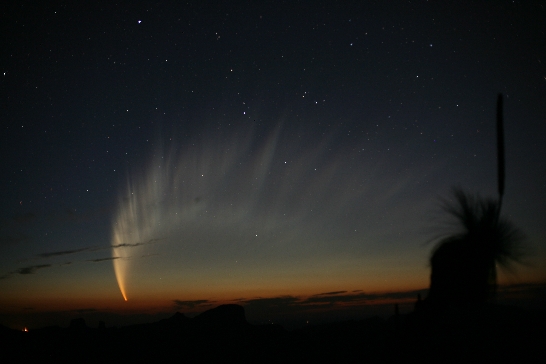
1 AU == 150 Mkm
Comets typically become visible 5 AU (Jupiter) from the Sun. This is the about the maximum distance that sunlight can vaporize water. They start out as fuzzy light balls indistinguishable from other beings except that they clearly move relative to the stars when tracked.
At 3 AU, the dust tail appears.
When the Comets near perihelion at 1.5 AU, the outgassing begins in earnest, and the ion tail appears.
Coma
The coma typically becomes bigger and brighter as the comet approaches the Sun, but when it is nearest, the coma actually diminishes because of some reasons. But overall, the brightness is proportional to (heliocentric distance)^(-4). Finally, the comet is typically brighter post-perihelion than it is pre-perihelion because of energy storage. For example, Halley's magnitude at (a) Outburst == 18.5; (b) Postperihelion == 18.5 to 8--; (c) Preperihelion == 25 to 10. The coma itself has a very bright center which diminshes to inverse r. The tails' brightness are relatively constant.
Outbursts are when comets because extremely bright, and can last for a few weeks. It doesn't have to do with how close the comet is to the Sun-- Schwassman-Wachmann I did it at 5 AU. Halley's (1991) brightness increased by 300 because it suddenly released a 300 Mkm radius of dust.
Split comets are when comets break into smaller comets. Comet Biela split into 2, but continued its orbit. The two parts formed tails, alternated in brightness, and even had a luminous bridge.
Tails
The ion tail is a streamy blue cone. The dust tail will be more like a fan in a plane, such that if viewed from the side it looks like a line. Depending on the composition, the ion tail or the dust tail will be bigger or not even exist. But this is unique to every comet and not contained in ordinary orbit data.
The ion tail doesn't actually point directly away from the Sun, but lags a few degrees due to aberration, which is how the solar wind's direction seems to change if we took the comet as the reference point. Since the comet itself is in fact moving, the solar wind's "direction" slants.
Disconnection events occur when the comets pass solar wind boundaries -- magnetic field lines of the solar wind reverses polarity -- or when pressure presses out the ionosphere and tail. The ion tail sloughs off, and soon the comet will grow another tail.
The appearance of an anti-tail is due to the parallax error of seeing the curve of a tail as another tail. This will depend on the observer's position relative to the comet.
Nucleus
There seems to be OBJ files of some prominent comets. If that is inadequate, it should not be hard to model some nuclei in Blender and export the models into OBJ files. If we were to be as accurate as possible, then the comets with existing OBJ files should be mapped to those files. As for unknown nuclei, there could be a small library of OBJ files to randomly choose from. I'm not sure when this is currently done in Stellarium, but this random choosing could be done during the swap from fuzzy coma to nucleus body.
The nucleus surface is somewhat smooth and doesn't usually have craters, because some dust that rises out during outgassing is too heavy and doesn't meet the escape velocity, so the nucleus surface is continuously covered afresh with dust. The shape itself should not be spherical- but irregular. They rotate and depending on which part is facing the sun, the vents in the comet body releases gas and dust.
Photographs do not accurately reflect the actual comet seen through a telescope. The necessary overexposure captures the coma as a simple fuzz ball without the details. The nucleus spews spiral and fountainlike shapes (drawings of Comet Tebutt)


Photos (expected appearance?):

^^^ This unusual display is suspected to be due to blocks of dust that were spewed out instead of just the usual thin constant stream.

^^^ Dust tail viewed relatively head on.

No comments:
Post a Comment